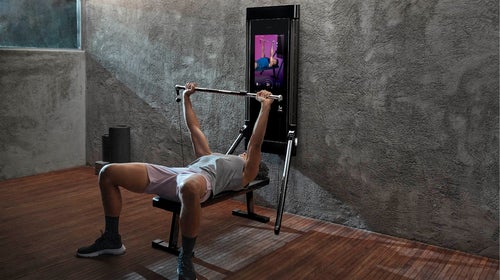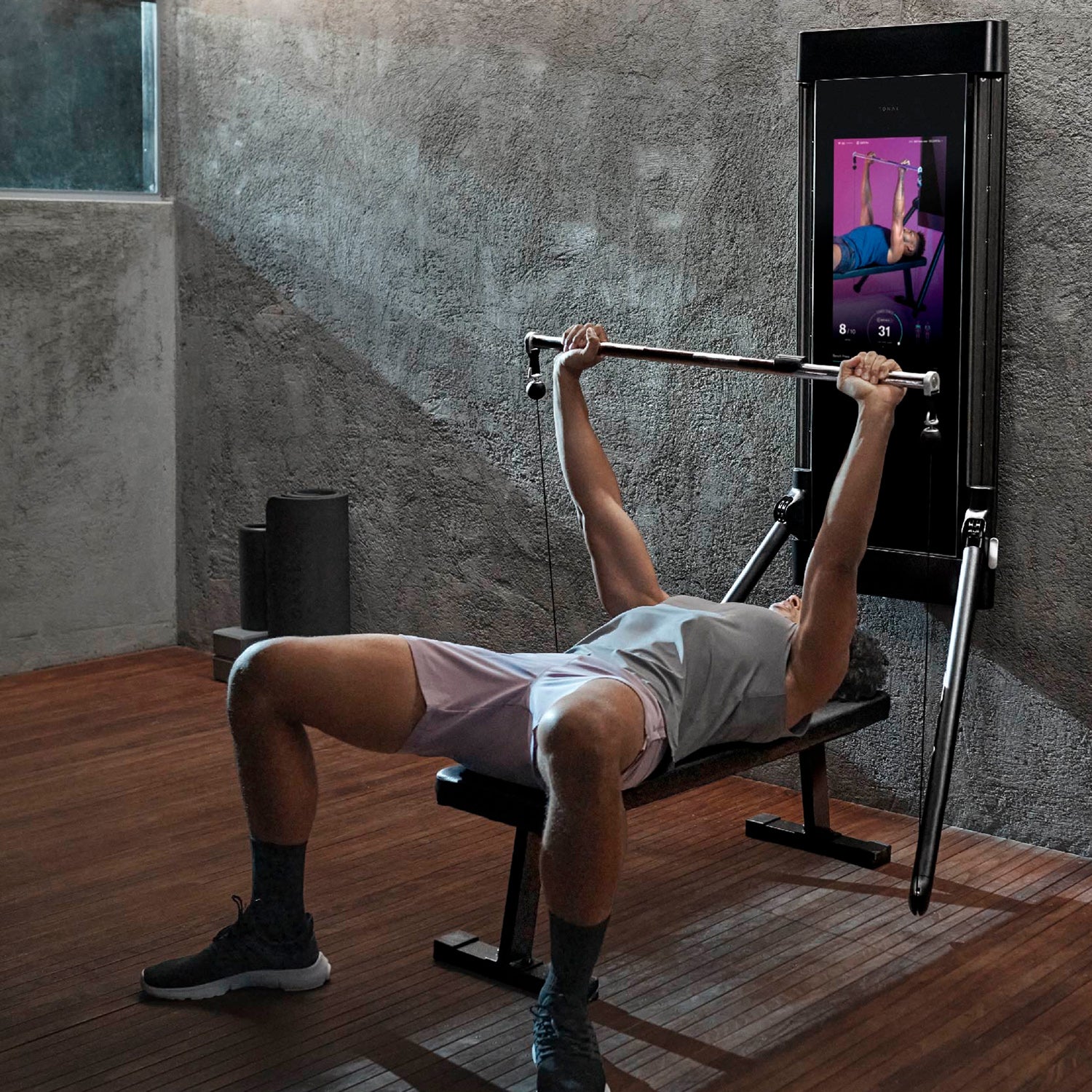In the nine months that I’ve been exercising exclusively on , I’ve completed 100 workouts, lifted 1.05 million pounds, and grown 71 percent stronger while gaining 10 pounds of lean muscle. In that same time, I’ve grown more flexible, and eliminated the chronic pain that’s plagued my back for over a decade. That’s the most progress I’ve ever made, in the shortest amount of time. Let me tell you how Tonal made that possible.��
What’s Tonal?
Tonal is the brainchild of veteran Silicon Valley engineer , who found himself struggling to lose weight while meeting long-hours work demands in the tech industry. His solution? To combine an electromagnetic motor, a cable crossover machine, and artificial intelligence into one slick, wall-mounted flat screen (complete with first-rate training content for guidance) to blend the benefits of a weight room and a personal trainer into one convenient device you can use at home, any time you want.��
The result goes well beyond other tech-enabled home fitness solutions that have become popular in recent years. While Peloton, and other bikes and rowers, allow you to experience group cardio classes at home, and wall-mounted displays like Mirror invite a personal trainer into your living room, Tonal does both—and more. It packs an entire weight room, personal training, live classes, and an unprecedented depth of fitness data into a single gadget.��
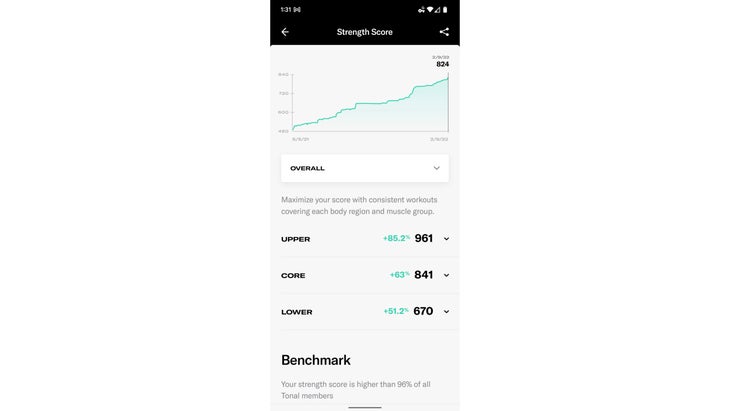
Digital Weight Turbocharges Results
I should state right from the beginning that Tonal doesn’t only offer a traditional weight lifting experience in a (much) smaller format. By using what’s essentially a scaled-down electric car motor to provide resistance, it can do things for your body no free weight can. Tonal calls its proprietary, patented electronic resistance “digital weight,” and it brings a myriad of extra benefits that go beyond classic barbells, dumbbells, and the like.��
By providing uniform resistance in its normal mode, digital weight eliminates your ability to overcome resistance with momentum. It’s also able to maintain uniform resistance throughout the movement pattern of any lift. Think about a barbell bicep curl. By contracting your muscles hard at the beginning of the move, you’re able to get free weights swinging, and the resulting momentum makes the rest of the move slightly easier. This ultimately means you experience less resistance, and limit your results. As you move a free weight in that curl out of the vertical plane, and into a horizontal curve, you also decrease the amount of resistance gravity is able to apply, so the top of the barbell curl is easier than the bottom, again limiting results. But on Tonal, every millimeter of every lift provides uniform resistance, no matter how fast, or through what planes you move the weight. (In other words, you can’t cheat.)��
For that reason, the effort required to move digital weight does not correspond to free weight. Tonal doesn’t make public a definitive multiplication factor, but consensus in the (surprisingly positive, encouraging) seems to be that digital weight provides 1.3 to 1.5 times the resistance of free weight, depending on the move in question. So dial a lift on Tonal up to 100 pounds, and it’ll feel as hard as moving 130 to 150 pounds of iron plates.��
That’s good, because the maximum resistance Tonal is currently able to create is 100 pounds of digital weight per arm. Attach the bar for, say, a barbell deadlift, and that maximum resistance is 200 pounds. Even at 1.5x, 300 pounds of resistance may not be enough for serious weight lifters.��
But you don’t need to use Tonal in static resistance mode. Push the weight icon on the touchscreen, and you’re given choices to enable spotter, burnout, chains, eccentric, and Smartflex modes. And it’s in using these features where Tonal can speed up the pace of your results.��
How Each Tonal Mode Works
Spotter mode is what it sounds like. If you struggle to complete a lift, it’ll reduce the weight gradually until you’re able to finish that rep. The benefit: you can safely push yourself as hard as possible, without requiring the presence of a human assistant.��
Burnout will, over time, reduce weight lift by lift (the amount and speed of this progression is determined by the AI’s ever-expanding knowledge of your capabilities), until you reach total muscle fatigue.��
Chains replicates the effect that draping heavy metal chains over a bar in the gym creates. This provides more resistance in both the concentric and eccentric components of a lift, as you near its top. And Tonal makes this possible on any lift, even ones performed with a single hand. Replicating that in a gym would be next to impossible.��
Eccentric mode is my favorite, and most users seem to believe it leads to the most rapid gains in strength. Because our muscles are able to support more weight through the eccentric phase of a lift than they are through the concentric, adding weight to the former helps build muscle. For example, in a barbell bicep curl, the concentric portion of that lift happens on the way up, and the eccentric happens on the way down. Arnold Schwarzenegger famously employed friends to to achieve this effect during his bodybuilding career. Tonal allows you to achieve the same thing, at home, by yourself.��
Smartflex is where the Tonal shows off its precision motor control and sophisticated machine learning capability. Again, picture the bicep curl. Your movement pattern, and areas of strength and weakness will look different from mine, and everyone else’s. By continuously altering the weight to suit each unique user, Tonal is able to provide optimal resistance through every millimeter of a lift. Let’s say I have a weakness between 34 and 46 millimeters into that curl. In Smartflex mode, Tonal will learn the exact location and degree of that limit, and reduce the amount of weight to address said weakness, then pile it back on where I’m strongest. The result? You’re able work your muscles as hard as possible throughout the entire movement, without the limitations created by unique limb length, or problems with joints.��
I’ve found Smartflex particularly useful in helping address weaknesses and imbalances create by old injuries. Following a motorcycle crash in which I knocked out my left knee and fractured my coccyx in seven places 10 years ago, I’ve struggled to bend into deep deadlifts. Employing Smartflex has enabled me not only to transition from a less optimal sumo position into a correct shoulder-width stance, but it’s also allowed me to make real progress on my deadlift for the first time since that crash.��
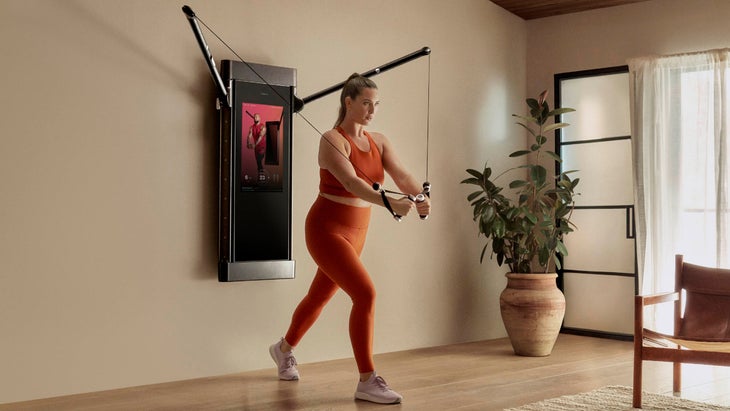
Cables, Without the Hassle
If you’ve used a cable crossover machine in a gym, you’re probably picturing how awkward, and difficult it might be to attempt to perform certain lifts using one. Take a barbell bench press. Attaching a bar to both cables, and positioning it over a bench, then getting yourself under that bar and pushing it into position would be awkward (and frustrating) with weight attached. But, Tonal’s smart handles and barbell have buttons that turn the weight on and off, which makes getting into position for any lift simple.��
The individual smart handles include buttons on both ends, so you don’t need to think about their orientation at all. (That button is always under your thumb.) The switch for the barbell clips on, so you can slide it around to suit any grip for any lift.��
These handles come as part of a $500 smart accessory add-on package, on top of Tonal’s nominal $3,000 price. For the up-charge you get: handles, a barbell, a rope attachment, a flat bench, a workout mat, and a foam roller. My opinion: I wouldn’t want to use the machine without the smart handles and bar.��
Weight can also be turned on and off via the touchscreen, and will also automatically turn off if Tonal detects that you’ve dropped the bar or handles. You can also simply tilt the bar to turn off weight if it’s attached to the cables and you find yourself struggling.��
The precision control, made possible by that miniaturized electric car motor, also allows Tonal to provide live-form correction and stabilize complicated movements, like squats. This doesn’t reduce the activation your stabilizer muscles perform in those lifts, it just reduces strain on joints like your knees.��
I have not found a single weight-room move that I can’t complete just as well on Tonal, with the exception of pull-ups. (Its arms aren’t designed to support the weight of a hanging human.) But, performing certain lifts using cables, instead of a dedicated machine or free weights, may take some modifications to your form and setup. Take chest flys, for example. Where you might normally do those on a machine while sitting upright, on Tonal, the best way to maximize resistance while maintaining correct form is to lay on the bench, with the handles down on the floor, and spread widely. When you first use Tonal, you may find that the cables or handles can chafe your arms, or even create bruises. Take the time to explore the range of available movements and you’ll easily find alternatives that work better on this unique machine.��
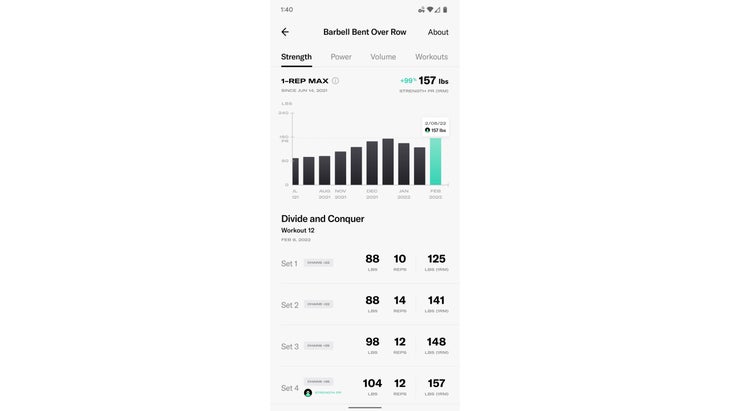
Personalized Progress
The first time you work out on a Tonal, you’ll need to complete a strength assessment. It’ll run you through a few cornerstone lifts like lat pulldowns and squats to collect feedback and establish your baseline strength. This enables the AI to suggest appropriate weights across all 200 plus available moves, and helps it build progress into those movements over time.��
By tracking every millisecond of every lift performed by every one of its users everywhere, Tonal is collecting an astoundingly unprecedented amount of data on weight lifting. And the way the company employs that data is one of the major benefits to you, the user.��
In traditional weight lifting, personal trainers can hold you accountable, show you proper mechanics, and suggest personalized programs to achieve your goals of building muscle, burning fat, or growing stronger. Using the data it gathers about your abilities, and those of all other Tonal users, the AI writes programs to build progression into its suggested weights better than ever before.��
When I finish this article, I’m going to go do a 45-minute shoulder workout on the machine. The first move is an overhead barbell press. By monitoring my abilities over the last nine months of use, Tonal will set a weight that gets me through all five sets of eight reps, while ensuring I make the most progress my unique body is capable of.��
I’m doing that workout as part of a four-week muscle building program divided up into a five-day split, created with the goal of maximizing muscle growth. Each workout features a pre-recorded video of a trainer explaining the moves, and their context within the program, then demonstrating correct form. The moves, volume, and interstitial corrective stretches included in the program are informed by all of the data Tonal collects across its user base. Where, in the past, a personal trainer might suggest doing a certain number of reps and sets of the overhead presses at a certain weight, and maybe add or subtract a few pounds as they watch me lift, Tonal is doing all that not just at a personal level, but informed by data collected over millions of lifts performed by tens of thousands of users. All that’s to say, this machine knows what works.��
I should add that Tonal’s programs are also written to provide total body function and mobility, not just muscle growth. By incorporating stretches and other mobility increasing movements into its weight lifting programs, the machine builds flexibility and joint health along with strength. I’ve lived with chronic, constant back pain for the last 15 years or so. Or I did. About a month into using the machine three to five days a week, that disappeared, and hasn’t returned.��
Tonal also gives you access to all of your own data. Where in the past lifters may have used a notebook to track weights, reps and sets, Tonal adds power output to the collected data, and also provides real-time feedback on your range of motion, encouraging you to dip deeper into squats or press further overhead.��
You can use that data to track and inform your progress over time with each individual lift. Tonal also adds its own unique twist on progress tracking and gamification through a metric it calls strength score. Because you can perform different moves to work the same body part (say barbell bench press, and alternating single-hand chest press, etc.), this allows you to develop a total picture of your progression over time, regardless of which moves you’re performing. Strength score is broken out by major muscle groups in your upper body, core, and legs, and compared to a universal baseline to assign each individual muscle group a number (see image below for my muscle group strength scores). Then it averages those groups out to assign a strength number for your total body (see image at the top of this article for my total-body strength score). You can use this to track and encourage progress, compare yourself to other users, and to see which areas of your body are tracking ahead or falling behind, regardless of which individual moves you’re performing.��
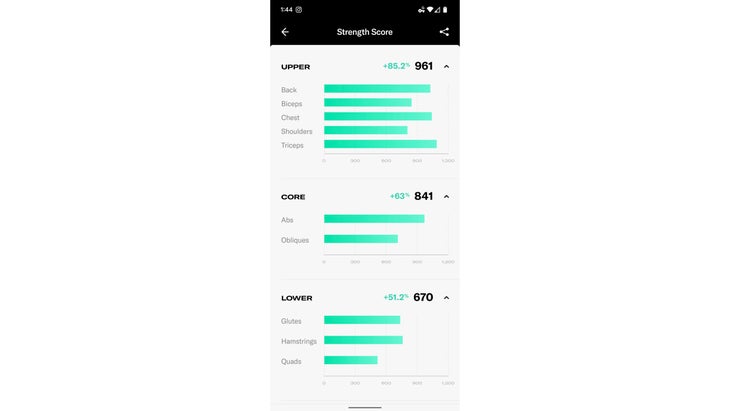
The Bottom Line: Cost-Benefit Analysis
Tonal isn’t cheap. The base price of the machine itself is $3,000. Add $500 to that for the absolutely necessary smart handles and other accessories. Tonal also requires that its machine is professionally installed ($300), and you have to sign up for a minimum of one year’s membership, which costs $50 a month. So, in total, you’re looking at $4,400 to own a Tonal in your first year.
That subscription fee is a frequent point of contention in online commentary. It should be noted that it’s per-household, not individual user. My wife, and several of my friends are able to use the machine I pay for, for free. While you can cancel the subscription after that first year, and continue to use the machine, you’ll be doing so without access to the training programs, live classes, or AI-informed weight progression, which together really make the Tonal experience special.��
But, what you get for that spend actually represents good value. Most high-end gyms cost at least $100 a month, and a personal trainer will cost at least that, per-session. Tonal comes with a three-year warranty, so spread its costs over that time, and it actually works out significantly cheaper than three years of gym membership, and 12 personal training sessions a year. What if you want to build your own gym at home? A quality home squat rack with weights costs at least $6,000.
You can, of course, perform bodyweight workouts for free, or employ much more affordable equipment like sandbags, kettlebells, or suspension straps.��
But the whole point here is that I’ve never experienced anything like the progress I’m making right now with Tonal. Not in a gym, not with a trainer, and not on other home equipment.
Last week, I set aside Tonal in favor of a regular gym so I could teach a friend’s teenage son how to lift weights for the first time. Before starting on Tonal, I couldn’t perform normal deadlifts with substantial weight, at all. But last week, with my feet at the correct shoulder width, I was able to pick up, and put down 225 pounds over four sets of ten reps, without even breaking a sweat.��
Right now, at 41 years old, nine months into owning a Tonal, I’m pain free, more flexible, and stronger than I’ve ever been.
